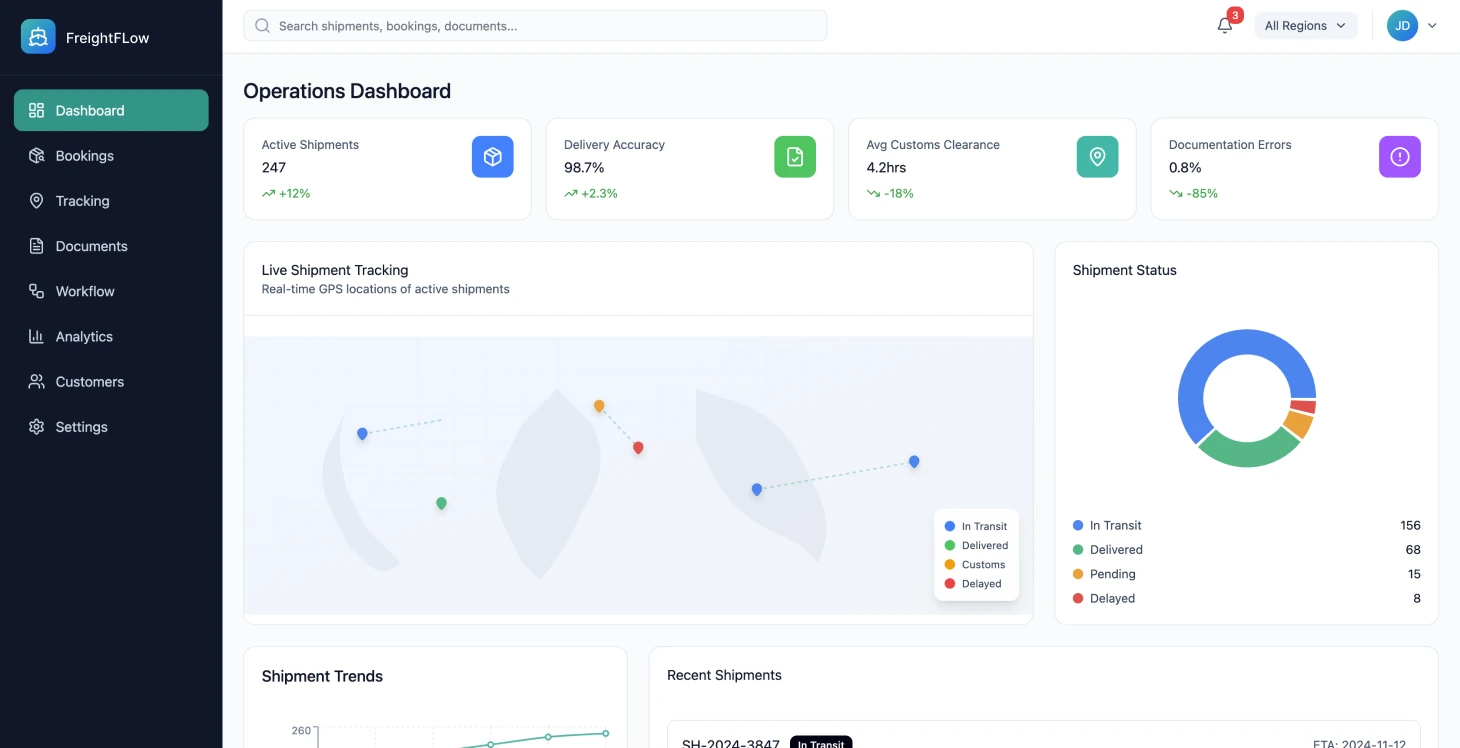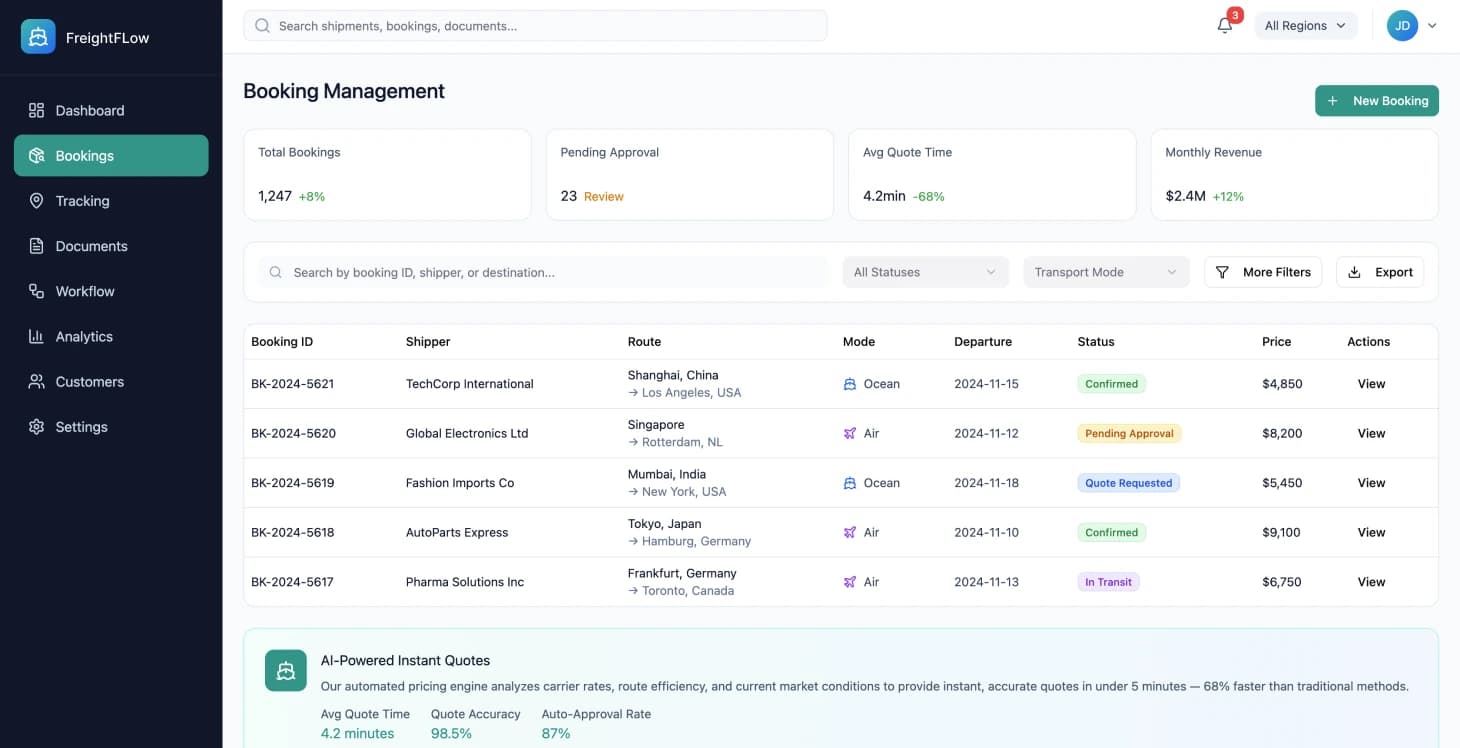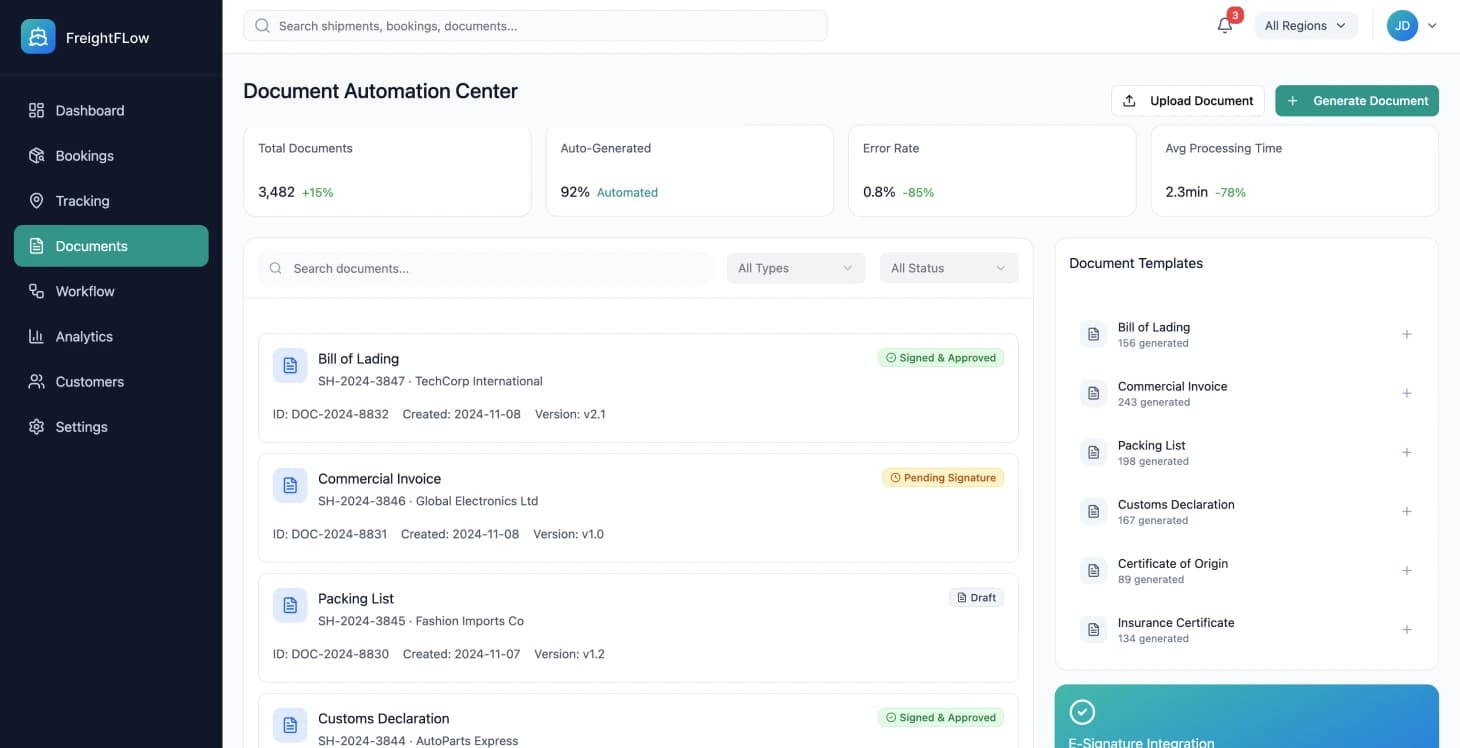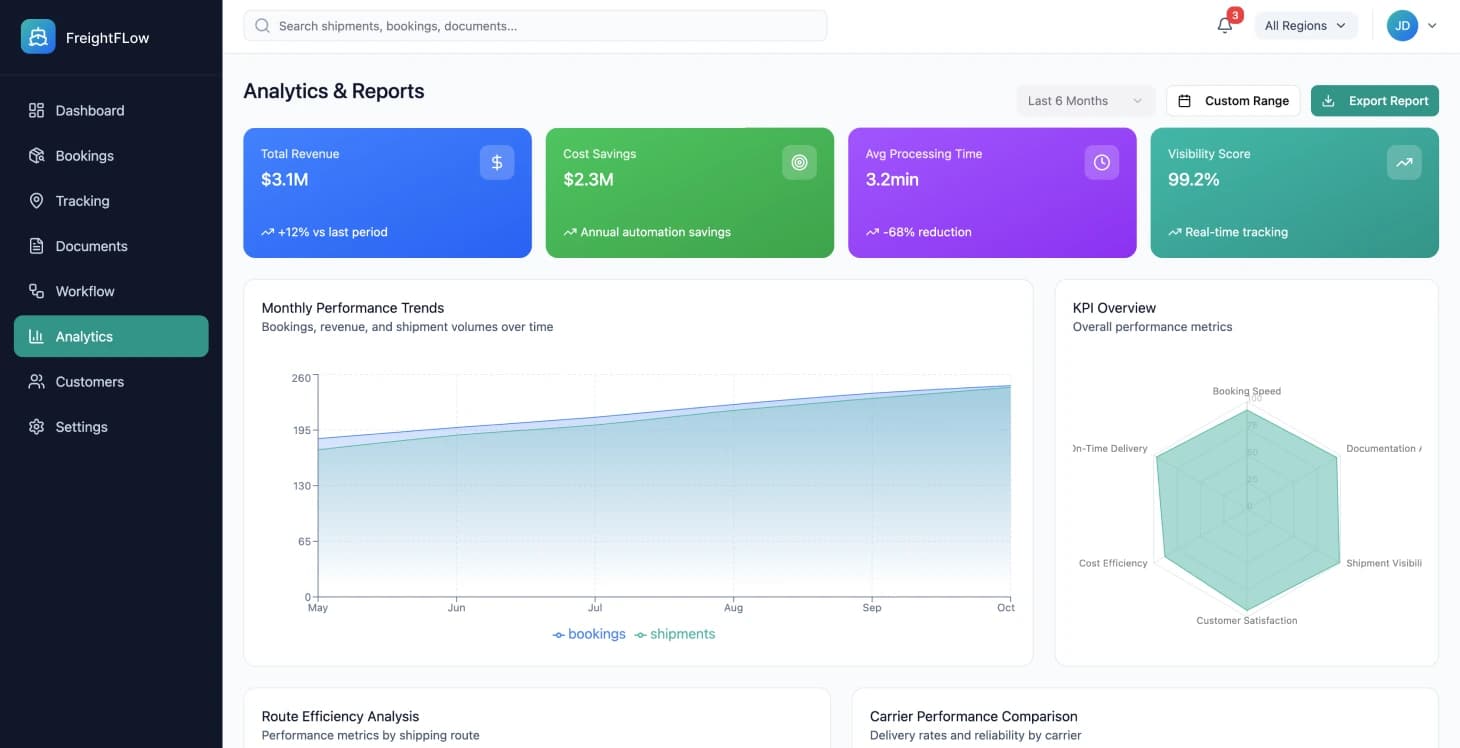



Project Overview
The global trade industry oversees around $4 trillion in transactions each year; however, it still heavily relies on outdated methods and systems. Our comprehensive digital transformation solution addressed traditional freight forwarding inefficiencies through a unified platform that combines shipment booking services with real-time tracking capabilities and automated document generation for supply chain logistics.
Traditional Challenges in Freight Forwarding
Freight forwarding operations have traditionally depended on manual methods and paperwork, along with systems that were not connected well. This led to inefficiencies and a lack of visibility throughout the supply chain.
The global trade industry oversees around $4 trillion in transactions each year; however, it still heavily relies on outdated methods and systems. Traditional practices require coordination among parties like:
- Shippers
- Carriers
- Customs agents
- Warehouse managers
Documentation needs encompass bills of lading, commercial invoices, packing lists, certificates of origin and customs declarations—often necessitating signatures and manual handling processes.
Legacy systems often work independently in entities; for instance, booking systems are not linked to tracking platforms and management of documents relies on email communications and shared files which can cause gaps in tracking shipments leading to delays and mistakes due to manual processes.
The sector is under increasing pressure to update its operations as customers seek more transparent services similar to those provided by Amazon while also dealing with rising trade volumes and changing customs regulations.
Key Inefficiencies Identified
The freight forwarding industry faced issues with inefficiencies due to manual procedures and system fragmentation presenting challenges such as:
- Manual Processing Steps: Making calls for shipment booking and exchanging emails along with manual data entry across different systems
- Quote Generation Delays: Taking between 24 to 48 hours due to the need for manual rate searches and calculations
- Documentation Preparation: Creating documents based on templates with manual data input which led to increased processing time and errors
- Limited Shipment Visibility: Clients faced challenges with receiving updates on shipment statuses as they had to depend on email notifications or phone calls
- Reactive Problem Management: Issues with shipments were typically identified only when deliveries did not reach their destinations as scheduled
Manual preparation of documents led to inconsistencies in customs declarations and commercial paperwork with version control problems occurring when several team members modified shipping documents concurrently.
These challenges are compounded by the need for documentation and audit trails across regulatory jurisdictions which adds an extra layer of complexity to the process.
Digital Platform Implementation
The implementation of a unified platform combines shipment booking services with real-time tracking capabilities and automated document generation. It also integrates workflow orchestration to create a comprehensive system.
Key Results Achieved
- 68% reduction in time taken for processing bookings
- 85% drop in errors related to documentation
- 99.2% visibility improvement for shipments due to real-time status updates
- $2.3 million cost savings achieved by implementing process automation and minimizing manual interventions within various operational teams
Revenue Growth and Market Expansion
The implementation of automated quote generation has significantly enhanced revenue growth acceleration by decreasing customer response time from 48 hours to 15 minutes – resulting in a 34% increase in quote-to-booking conversion rates.
The introduction of self-service booking features has granted customers round-the-clock accessibility, paving the way for extended market reach across time zones. Additionally, the adoption of dynamic pricing models has successfully eliminated inconsistencies in quotes and bolstered margin predictability.
Operational Cost Reduction
The reduction in costs was achieved through process automation which lowered the need for manual labor by 40%, particularly in booking and documentation teams. With the decrease in errors came a reduction in rework and delays at customs and also streamlined efforts to resolve client disputes.
Vendor management was simplified by integrating platforms which led to decreased expenses related to technology licensing and maintenance costs.
Enhanced Customer Experience
- 80% reduction in status inquiry calls by providing real-time shipment visibility
- Automated exception alerts allow proactive communication with customers about delays or issues
- Digital document delivery enhanced security while reducing courier costs
Compliance and Risk Management
Automating validation rules helped decrease customs documentation errors by 85%, leading to reduced penalty risks and fewer delays in shipments. Centralized audit trails enabled comprehensive tracking of document creation and approval processes.
Scalability Achievements
The platform's architecture efficiently handled a 300% increase in transaction volume without needing proportional staff growth. This was supplemented by API integrations that facilitated the inclusion of new carrier and logistics partners. The support for multiple languages and currencies played a crucial role in successful expansion into new geographic markets.
Transform Your Freight Operations Today
Discover how digital transformation can reduce your processing time by 68% and save millions in operational costs.
Technical Architecture
Microservices Structure
The online shipping platform chose to use a microservices structure to tackle system disorganization while maintaining adaptability efficiently. Key architectural concepts involved:
- API-first integration approach
- Event-driven processes
- Modular component design
- Business-specific freight forwarding expertise
Rather than replacing existing systems, the platform served as the integration point for legacy systems and external sources, including carrier APIs and data sources, reducing implementation risks and enhancing data consolidation benefits.
Core System Components
Workflow Automation entails automating business processes that target rule-based tasks through smart contract development such as:
- Generating quotes
- Confirming bookings
- Preparing documents
- Sending status notifications
The customizable workflow engines enable tailoring for different trade lanes and service types without requiring code alterations.
Event Streaming Architecture enabled quick shipment tracking by combining data from carrier EDI feeds, IoT sensors, and manual updates for near real-time processing of information. Consistent status reporting was achieved across different carrier systems and data formats through data normalization.
Self-Service Capabilities allowed customers to book shipments and track them directly without needing assistance from staff for routine tasks. The mobile-friendly layout made it easy for warehouse and transportation teams to access information in the field.
Integration Layer
The central hub integrates with more than 50 carrier systems along with customs platforms and banking APIs using an Enterprise Service Bus (ESB). It manages connections and handles processing of various tasks such as EDI transactions and document generation through message queues for status updates.
Security Framework
The security framework utilized OAuth 2.0 and JWT tokens for user authentication and API access control while role-based access control (RBAC) ensured data separation among client entities was maintained effectively. Additionally, end-to-end encryption was employed to safeguard sensitive financial information both during transit and when stored securely.
Integration Components
| Component | Function | Key Features |
|---|---|---|
| API Gateway Layer | Request management | Authentication, rate limiting, request routing |
| Integration Adapters | Data normalization | Carrier system compatibility, format standardization |
| Message Queues | Asynchronous processing | Status updates, document generation |
| Enterprise Service Bus | System connectivity | 50+ carrier integrations, customs platforms |
Implementation Approach
Three-Phase Rollout
Implementation was carried out in three phases to reduce disruptions effectively:
- 1.Phase 1: Core booking and tracking services for shipments
- 2.Phase 2: Advanced functionalities and document management features
- 3.Phase 3: Analytics tools, mobile apps, and extended partner integrations
Data Migration and Integration
During the data migration process, ETL pipelines were used to clean and standardize shipment records from legacy systems efficiently, ensuring data consistency during parallel operations periods by implementing synchronization techniques. Additionally, seamless API integration with accounting and CRM systems maintained established business workflows.
Testing and Quality Assurance
Comprehensive testing covered:
- API functionality testing with focus on integration scenarios
- End-to-end business workflow assessment
- Load testing for peak transaction volumes
- Security testing including penetration testing and vulnerability assessments
Training and Change Management
Role-specific training initiatives were tailored for different user roles such as booking agents, customer service representatives, and operations managers. Practice sessions in sandbox environments offered hands-on experience without impacting live data systems.
Change management strategies focused on implementing workflow changes and introducing new processes effectively while involving personnel in decision-making processes and prototype testing.
Performance Optimization
Database and System Performance
Database indexing techniques were fine-tuned to enhance the speed of frequently used operations like rate inquiries and tracking shipments, leading to improved query performance. CDN implementation helped decrease loading times for users while caching layers efficiently reduced the need for repeated API requests to carrier systems.
Risk Management Strategy
The company's risk management strategy involved:
- Backup plans to handle manual tasks during system downtime
- Business continuity focus on four-hour recovery time objectives
- Gradual feature rollout to allow quick reversal if problems arose
- Circuit breaker strategies to prevent cascading failures during carrier system downtime
Results and Impact Analysis
Quantitative Results
The platform transformation brought about significant enhancements in effectiveness, customer satisfaction, and financial outcomes. Metrics were assessed over 18 months before and after implementation:
Operational Impact
Automation Benefits: The automation of routine tasks liberated 320 hours per week of staff capacity to be reallocated to customer-facing and strategic endeavors. There has been a shift in exception handling from reactive to proactive; now 78% of issues are identified and resolved before affecting customers.
Financial Results:
- Direct cost savings: $2.3 million per year through reduced labor expenses and fewer processing mistakes
- Revenue growth: 28% increase due to enhanced customer acquisition and retention
Customer Satisfaction
Net Promoter Score saw a rise from 23 to 67 as customers noted improved communication, quicker responses, and reduced paperwork hurdles as key factors in their satisfaction levels. Customer retention rates showed a 22% increase compared to the previous year.
Compliance Improvements
- 91% reduction in customs penalties thanks to improved accuracy in documentation
- Automated validation processes implementation
- Audit preparation time reduced from 3 weeks to just 2 days through centralized documentation and automated reporting features
Key Performance Improvements
| Metric | Before | After | Improvement |
|---|---|---|---|
| Operational cost per shipment (USD) | $125 | $78 | 38% reduction |
| Staff productivity (shipments per FTE per day) | 12 | 19 | 58% increase |
| Payment processing success rate | 94% | 99.8% | 6% increase |
| Customer portal availability | 96% | 99.8% | 4% improvement |
Lessons Learned and Best Practices
Implementation Challenges
Carrier API Integration turned out to be more complex than expected because of varying data formats and reliability concerns. A proactive approach of incorporating adapter patterns and circuit breakers during design stages could have shortened the development timeline and enhanced system robustness.
Change Management: There was initial resistance to user acceptance which led to increased training efforts and modifications in workflow design. Involving personnel in decision-making processes and prototype testing contributed to better user experience outcomes.
Data Quality: Ensuring data quality from the start proved crucial as cleaning legacy data demanded more time than expected. Emphasizing early data assessment in project planning and enforcing validation rules during migration prevented the spread of existing data problems.
Technical Recommendations
Scalability Design: The original database layout needed optimization when transaction numbers surpassed expectations. Incorporating horizontal scaling methods and data partitioning early could have prevented performance issues during peak times.
Vendor Relationships: Establishing strong partnerships with vendors is crucial for managing carrier integration timelines. Setting up integration agreements and service level agreements (SLAs) from the beginning enhances project predictability.
Monitoring Strategy: Initially, monitoring focused on technical performance rather than business KPIs. Introducing business process monitoring and automated alerts for process deviations enhanced visibility and enabled quicker issue resolution.
Utilizing feature flags allowed for gradual introduction of functionalities and quick reversal in case of problem detection, proving extremely beneficial in managing risk during carrier integration launches and major feature rollouts.
Technical Infrastructure Details
Core System Architecture
The system utilizes a cloud-based design implemented on scalable platforms to support varying activities and fluctuating workload requirements:
- API Gateway: Handles request routing, authentication, and rate limiting
- Database Layer: Transactional data stored in primary database, supported by read replicas for reporting purposes
- Performance Optimization: Load balancing and content delivery networks (CDNs) utilized to enhance performance efficiency
- Notification Service: Sends alerts through email and text messages according to business rules
- Billing Service: Manages invoicing procedures as well as payment processing and revenue recognition
This comprehensive digital transformation demonstrates how modern technology platforms can revolutionize traditional freight forwarding operations, delivering substantial improvements in efficiency, cost reduction, and customer satisfaction while maintaining the reliability and compliance standards essential for global trade operations.
Project Results
- 68% reduction in processing time
- 85% drop in documentation errors
- $2.3 million annual cost savings
- 300% increase in transaction volume handled
- 99.2% shipment visibility improvement
Key Performance Metrics
Processing Time Reduction
Booking processing time
Cost Savings
Annual operational savings
Documentation Errors
Error reduction rate
Volume Capacity
Transaction volume increase


